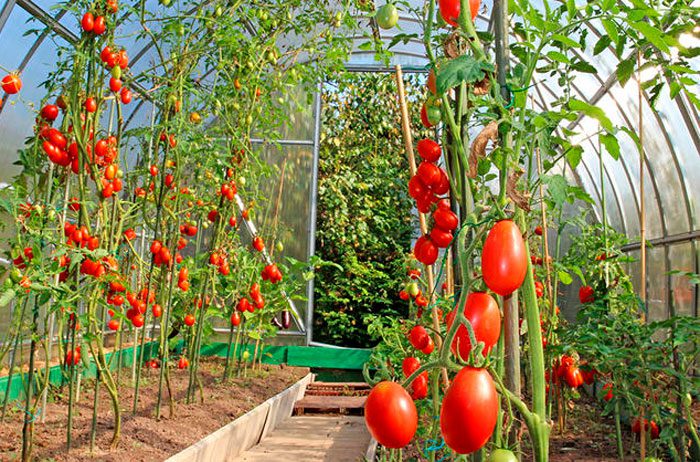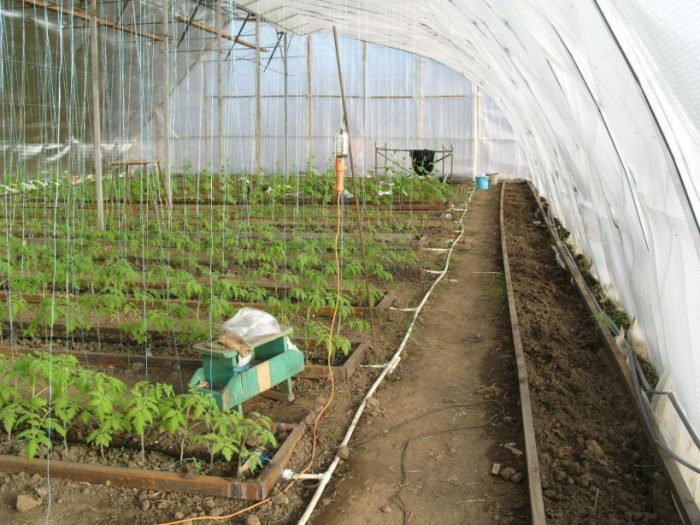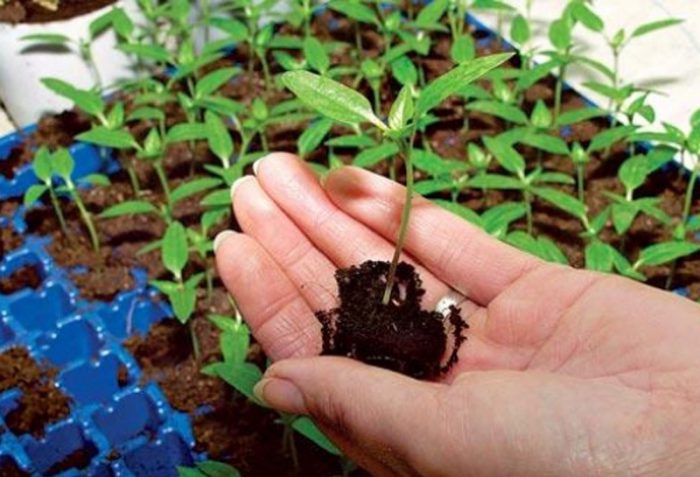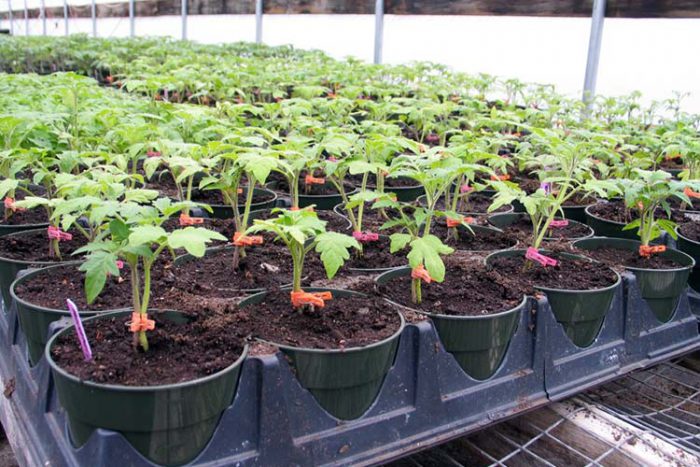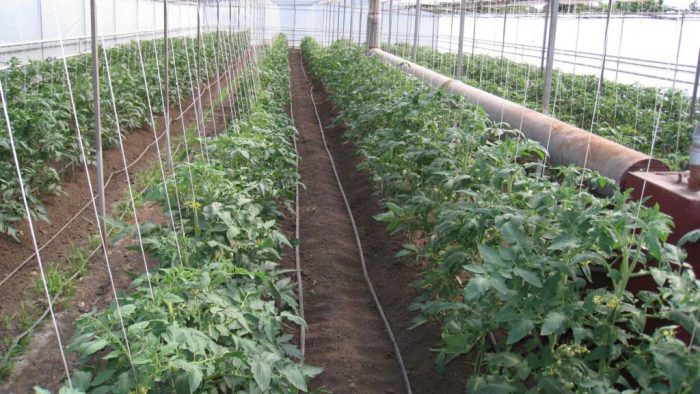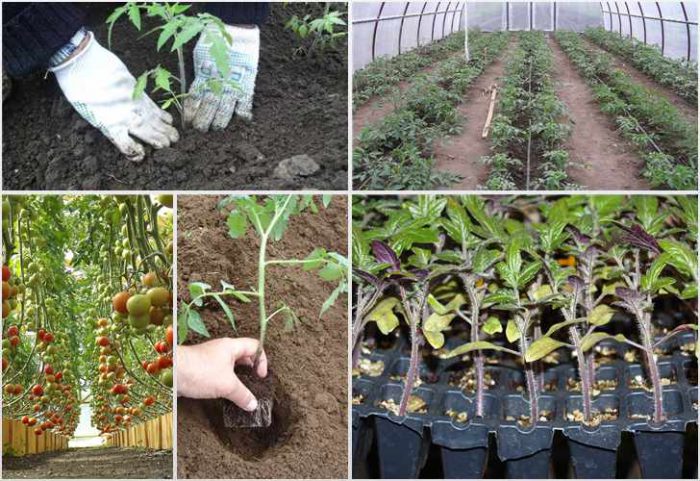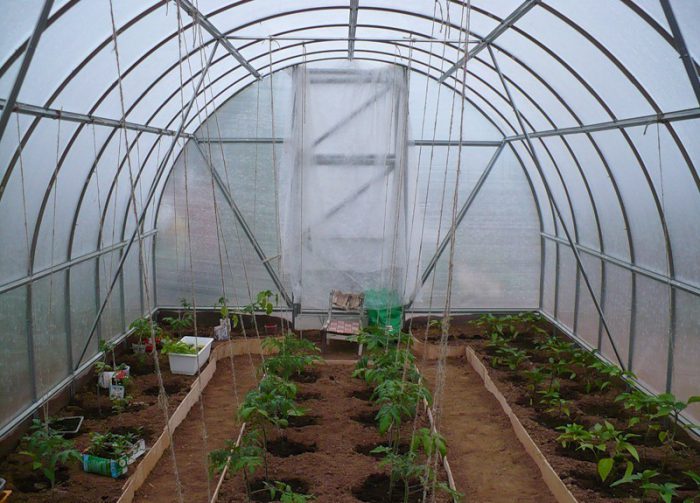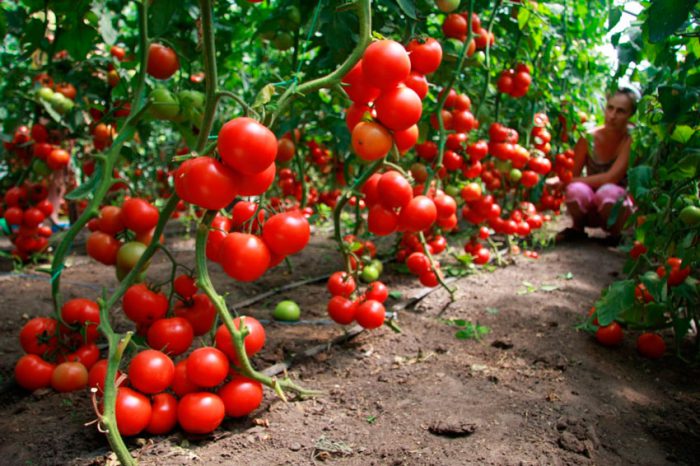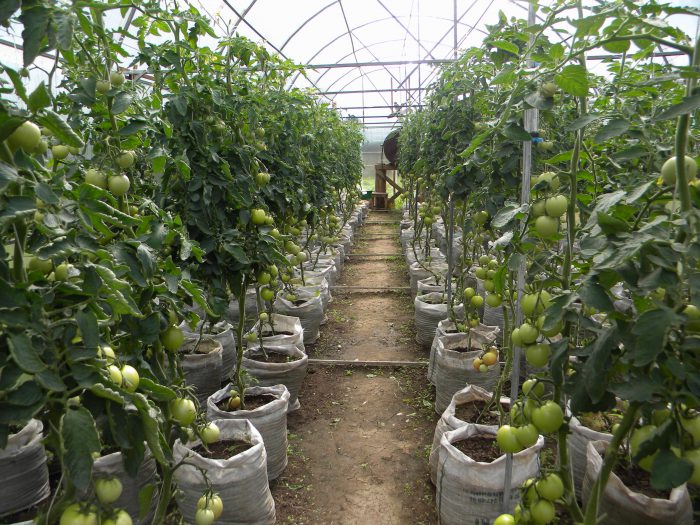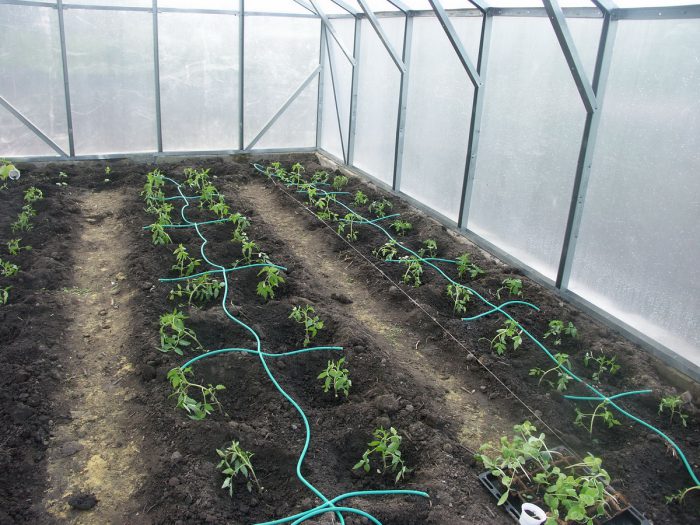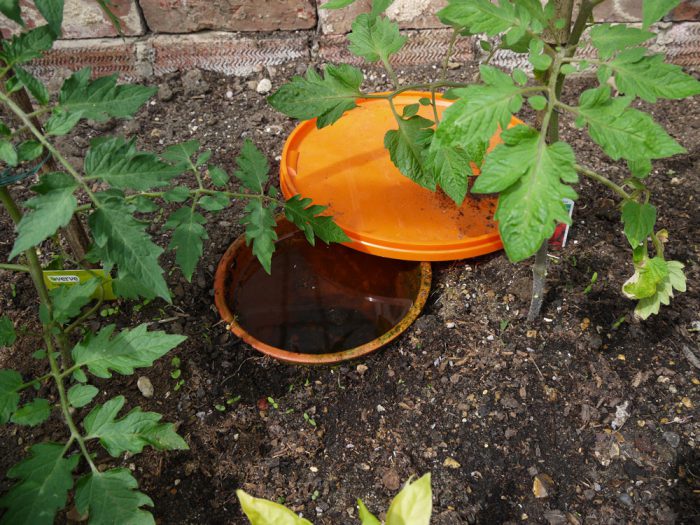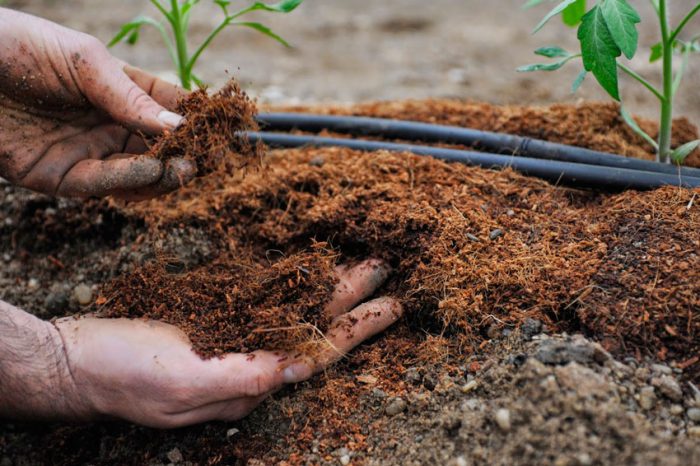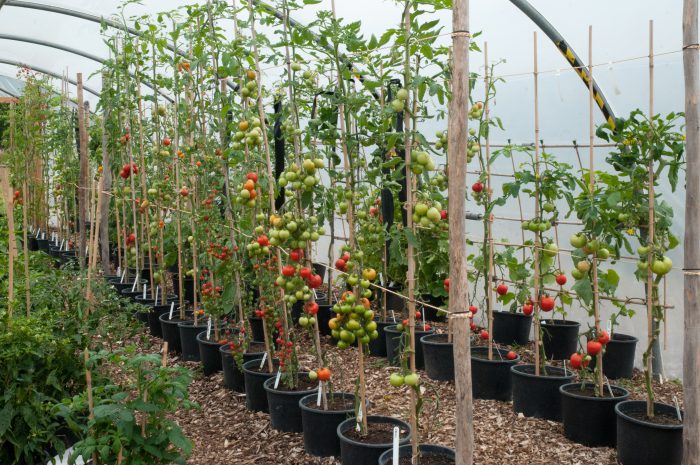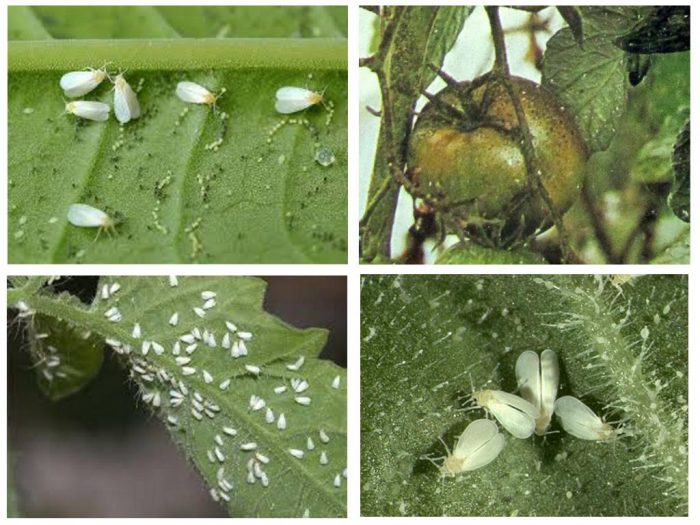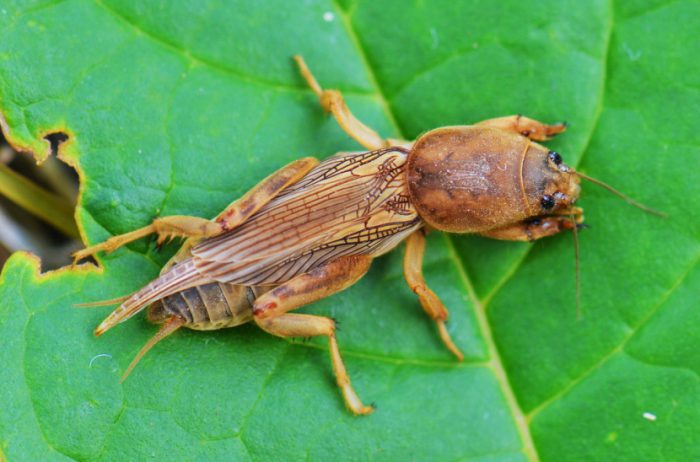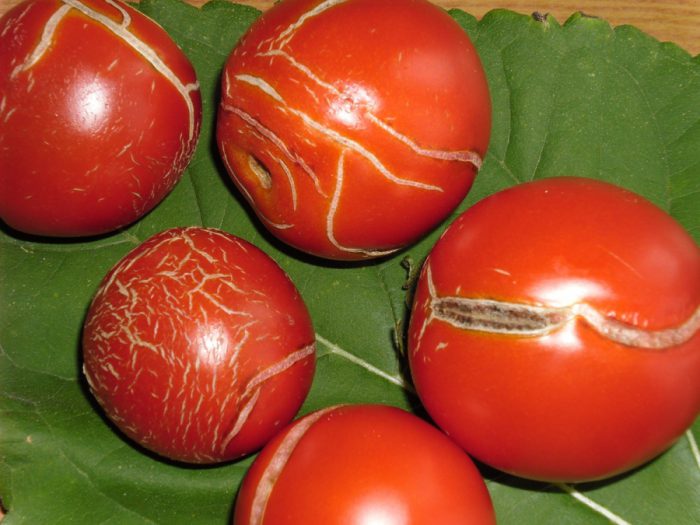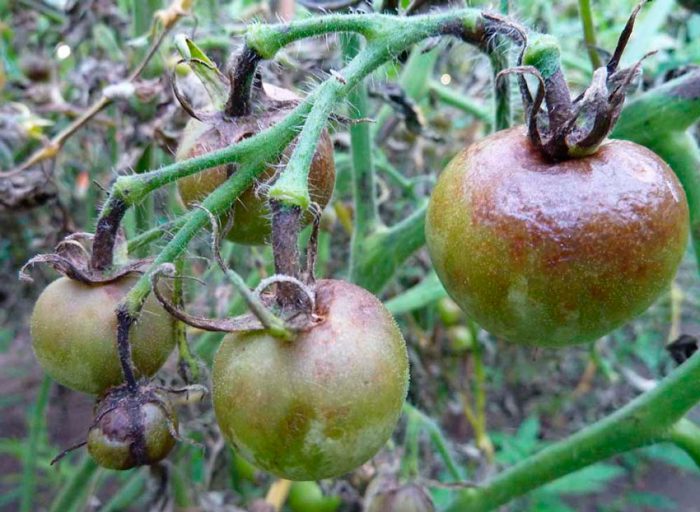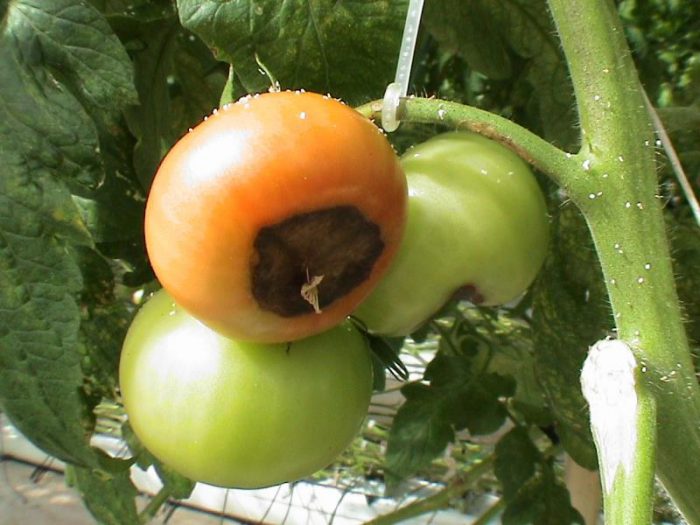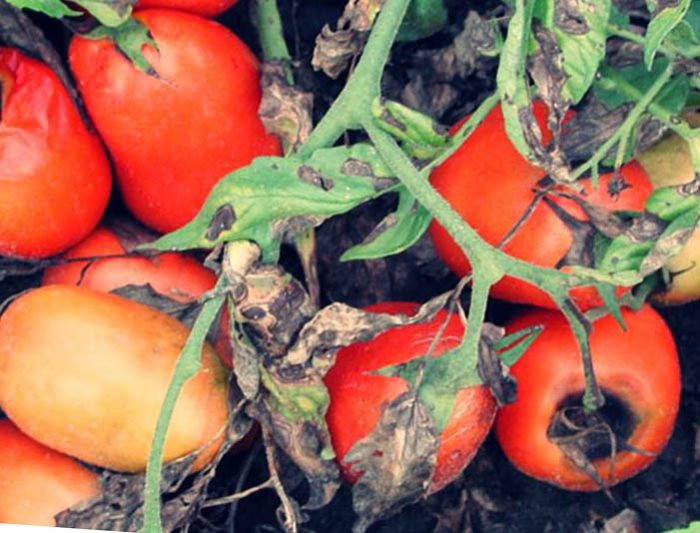No matter how much you would like the summer to last for a very long time, it still ends. The gardeners collect the entire crop from the garden, and nothing grows on it. Of course, many people stock up on a variety of canned food, pickles and jams for the winter, but they are unlikely to be able to become a full-fledged replacement for fresh vegetables and fruits, especially in early spring, when vitamins are so lacking. However, many years ago, greenhouses were invented in which various crops can be grown. After all, it is so pleasant to eat fresh tomatoes and cucumbers from your greenhouse in the middle of winter, and you can also sell them if you wish. Below it will be described how to cultivate tomatoes in a greenhouse made of polycarbonate or other materials; how to ensure that the fruits ripen by a certain date; what time to harvest; what varieties are suitable for cultivation in greenhouse conditions; how you can regulate fruiting and much more.
Content
- 1 Growing tomatoes in a greenhouse
- 2 How to grow tomato seedlings from seeds
- 3 Transfer to the greenhouse
- 4 Caring for tomatoes in the greenhouse
- 5 Tomato pests and control in the greenhouse
- 6 Greenhouse tomato diseases and treatments
- 7 Collection and storage of tomatoes
- 8 Tomato varieties and types suitable for the greenhouse
Growing tomatoes in a greenhouse
Tomato greenhouses
The advantage of greenhouses is that they can grow tomatoes all year round, in addition, such plants give a richer harvest, since they do not undergo sudden changes in temperature, frost, and precipitation. However, it is only in a properly made and equipped greenhouse that conditions can be created that are ideal for growing tomatoes.
For the construction of a greenhouse, you can choose different materials, namely: glass, film or polycarbonate. It should be borne in mind that all such materials have both their pros and cons. It is also worth considering that most gardeners prefer greenhouses made of polycarbonate.It is recommended to choose aluminum for the frame of the greenhouse, because it is distinguished by its lightness and high resistance to rust.
When choosing a place for a greenhouse, one must take into account that tomatoes need a lot of light for normal growth. In the event that the illumination is scarce, the bushes must be planted at a considerable distance from each other so that they are not in shade. This means that either you will grow fewer bushes, or you will need to make a very large greenhouse.
For year-round growing of tomatoes, the greenhouse must be equipped with a heating system, which can be gas, steam, electric or air. The most economical option is stove heating, you just need to install a boiler that is heated with wood. When installing gas heating, you will need to systematically ventilate the greenhouse. Installing electric heating is the most expensive option.
Regarding watering tomatoes, experienced gardeners recommend using a drip system, while you can choose both tapes and bring a dropper to each bush. To automatically regulate watering, use dedicated controllers.
Do not forget about good ventilation in the greenhouse. For this, it is recommended to make several vents. Airing will not only avoid air stagnation, but will also greatly improve plant pollination. Most often, such vents are recommended to be made in the upper and lower parts of the greenhouse.
In the event that the greenhouse has already been built and it is already several years old, then before proceeding with planting seedlings, it must be completely disinfected. Those greenhouses that have a wooden frame must be fumigated using sulfur. First, you need to seal all the cracks and holes in the room. Then sheets of metal are laid out on the floor, and sulfur is laid out on them, which is pre-mixed with kerosene. After that, sulfur is ignited. It should smolder for 5 days, during this time the greenhouse should not be opened. After such disinfection, all fungi, mold, pests, pathogenic microorganisms and other infections will be destroyed. If the greenhouse has a metal frame, then this method of disinfection is not suitable for it, the fact is that sulfur promotes corrosion of metal structures. In this case, it is recommended to use bleach. For half a bucket of water, 200 g of bleach is taken, everything is stirred and infused for 4 to 5 hours. With this solution, it is necessary to completely treat the entire inner surface of the greenhouse, then it is tightly closed for 2 or 3 days.
When the greenhouse is disinfected, it should be thoroughly ventilated and cleaned with a brush. A metal structure is poured over with freshly boiled water, and a wooden structure is wiped with a solution prepared from copper sulfate.
How to grow tomato seedlings from seeds
Sowing tomato seeds for seedlings
For growing tomatoes, the seedling method is used. Such seedlings intended for a greenhouse can be grown directly in it, as well as in room conditions. It is recommended to sow seeds for seedlings from the first days of February to the last March. Early ripening varieties are sown at the end of March, mid-ripening ones - during March, and late-ripening ones - in February. Before starting sowing, seed treatment should be carried out. If the purchased seeds are pelleted (have a rich color), then they can be planted without preparation in the substrate. All other seeds need pre-sowing preparation. To do this, they are put in a solution of Fitosporin-M for a third of an hour, then they are poured into a tissue bag and put for another third of an hour in a solution of a drug that stimulates growth (for a liter of water, ¼ part of a small spoonful of sodium humate powder).After that, they can be sown in a loose and light substrate (it can be purchased in a special store, for example, "Tomato and Pepper", "Living Earth", etc.). And for sowing seeds, you can use sod or humus soil.
On the surface of the substrate, shallow (10-15 mm) grooves must be made, while the distance between them should be from 5 to 7 centimeters. They must be well watered with lukewarm water and only then the seeds should be spread. The distance between the seeds should be 15–20 mm. Then the seeds are sealed, the container is covered with glass or foil on top, and it is placed in a well-lit place. A stand should be placed under the box, since air should flow freely to the root system from below. The optimum temperature for seedlings at this time is from 22 to 24 degrees.
Growing tomato seedlings in a greenhouse
If the crops are placed in the most suitable conditions for them, then the first seedlings can be seen after 7 days. When the first shoots appear, the cover from the container must be removed for good. The growth of seedlings is relatively slow for the first 20 days, the next 2-3 weeks the leaves of the seedlings begin to grow rather quickly. After 5–5.5 weeks have passed since the seedlings appear, their height will be decent, and the leaves will reach a fairly large size. From this point on, the gardener should try to prevent the seedlings from pulling out, for which they should be placed in a very well-lit place. In addition, every day the plant should be rotated 180 degrees around its axis, thus it is possible to achieve that the lighting is more uniform.
In the first 7 days after the emergence of shoots, the temperature must be from 16 to 18 degrees during the day, and from 13 to 15 degrees at night. After a week, the temperature should be increased from 18 to 20 degrees during the daytime and 15-16 degrees at night. This temperature should be maintained until 2 or 3 true leaves appear on the plants.
During all this time, watering the plants should be done only 2 or 3 times. So, with low natural light in March, such watering will help to avoid pulling out the seedlings. The first time is watered after the seedlings appear, the second time - after 7-14 days, and the third time when 3 hours remain before the pick. Moderate watering should be carried out at the root, while the water temperature should be about 20 degrees.
Plants should be fed for the first time only after planting in the greenhouse. After the seedlings have 2 or 3 true leaves, they should be picked into individual pots 8x8 centimeters in size. The soil mixture should be taken the same as for sowing. The dived seedlings are watered with a solution of potassium permanganate (0.5 gram of the product per bucket of water). Only the strongest and healthiest plants should dive, and the diseased and weakened plants should be removed. In the event that the plants are elongated, then their stalk can be slightly deepened (not to the cotyledon leaves). After picking, tomatoes are kept at a temperature of 20 to 22 degrees during the daytime and 16-18 degrees at night. After the seedlings take root, the temperature can be lowered to 18–20 degrees during the day and 15–16 degrees at night. Watering is done every 7 days.
When 14 days have passed from the moment of the pick, you should feed the plants for the first time. To do this, use a solution of Nitrofoski (1 large spoonful of the drug per bucket of water). For 1 tomato, half a glass of such a solution should go.
In the event that the seedlings begin to stretch out or outgrow, then after 20-25 days they should be planted in pots, the size of which is 12x12 or 15x15 centimeters, while the tomatoes do not need to be buried. After transplanting, watering should be carried out, while the water temperature should be 22 degrees. Subsequently, watering should be carried out no more than 1 time in 7 days. In transplanted seedlings, their growth is inhibited, and the root system is strengthened.After 14 days, the plants are fed with a solution consisting of a bucket of water, 1 tbsp. l. fertilizer "Signor Tomato" and 1 tbsp. l. superphosphate. For 1 plant, 1 tbsp is taken. such a solution. After another 14 days, it is necessary to feed the seedlings again with a solution consisting of a bucket of water and 1 tbsp. l. Nitrofoski, while 1 tbsp is taken for 1 bush. nutrient mixture. Top dressing of tomatoes must be combined with watering. In the event that the soil mixture has settled in the container, then you need to add some fresh substrate.
Hardening of plants begins in April or May, for this in the room you need to open the window for a short time. Day by day, the duration of hardening should be increased, but there should be no drafts in the room. If it is warm outside, then the tomatoes can be transferred to fresh air (balcony) for 2 hours. When the seedlings are hardened, they will have a purple-blue hue. During hardening, the substrate in the pots must be damp, otherwise the plants will wither.
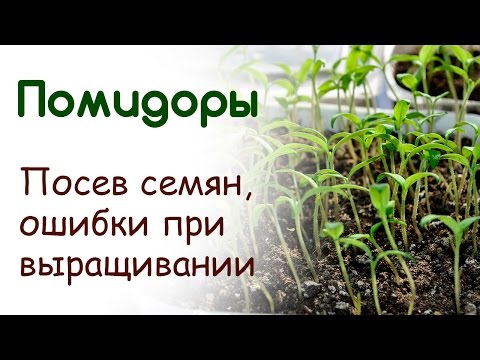

Watch this video on YouTube
Transfer to the greenhouse
What is the time to transplant tomatoes into the greenhouse
Seedlings should be transplanted into the greenhouse after their height is from 25 to 35 centimeters, and on the stem there will be 8-12 developed leaf plates and 1-2 formed inflorescences. Seedlings that are 50 days old are best suited for planting. 2-3 days before transplanting, the plants must be prepared, for this they cut off 2 or 3 of the lowest leaf plates, while sufficiently long (15-20 mm) hemp should remain from them. As a result, the likelihood of disease is reduced, the air circulates much better, and the plants receive even illumination.
Planting seedlings in heated glass greenhouses should be done in the last days of April, in the first days of May. If the greenhouse is unheated, but has an additional film covering, then the landing is carried out in the first decade of May. If the greenhouse is cold and does not have additional shelter, then the planting is carried out in the second half of May. Seedlings are planted in open soil under a film cover in the last days of May, the first in June. At the same time, it is very important that during planting, the soil temperature in the beds at a twenty-centimeter depth is at least 13 degrees, while the air temperature should be from 20 to 25 degrees.
Soil for greenhouse tomatoes
It is recommended to replace the soil in the greenhouse once every 5 years. The fact is that during this time the soil is significantly depleted, even if fertilizers are regularly applied to it. Disinfection of the soil should be carried out every off-season, for this, Bordeaux liquid (1%), a solution of copper sulfate (1%) or dolomite flour (50 grams of substance per 1 square meter) are used.
For early tomatoes, the preparation of the beds is carried out in the autumn. Some gardeners advise to lay an additional insulating layer under the soil, so you can lay a layer of sawdust, pine needles or straw, while its thickness should be 10 centimeters. Then a layer of compost of the same thickness should be placed on top, and soil should be laid on top of it. In this case, the final height of the bed should be about 30-40 centimeters. For the cultivation of tomatoes, sod or humus soil is used. Fertilizers need to be added to it for digging, so 3 tbsp is taken per 1 square meter. l. double granular superphosphate, 1 tbsp. l. potassium sulfate and potassium magnesium, 1 tsp each. urea or sodium nitrate and 1.5 tbsp. wood ash. If the soil is clay or loamy, then together with fertilizers, 1 bucket of humus, sawdust and peat is introduced into it. If the soil is peat, then 1 bucket of humus, sawdust or small shavings, turf soil and ½ bucket of coarse sand are applied per 1 square meter together with fertilizers.
How to plant tomatoes in a greenhouse
Early ripening undersized tomatoes, which have 2-3 shoots, should be planted in a checkerboard pattern, while the distance between the bushes should be from 35 to 40 centimeters, and the row spacing should be from 50 to 55 centimeters.
Standard, as well as determinant species should be planted, leaving a distance of 20 centimeters between the bushes, and the row spacing should be made from 45 to 50 centimeters. Thanks to this planting scheme, about 10 bushes are placed on a square meter.
Tomatoes of giant varieties are recommended to be formed into 2 stems and planted in a checkerboard pattern. The distance between the bushes is from 55 to 60 centimeters, while the row spacing is from 75 to 80 centimeters.
There is also a planting scheme, with which it will be possible to grow tomatoes of various varieties on the same bed. Landing should be done in 2 rows:
- The first row should be located in the immediate vicinity of the film or glass. It is necessary to plant determinant early ripening varieties, while leaving a distance of 35 to 40 centimeters between the bushes, they should be formed into 1 stem.
- The second row should be located closer to the aisle, tall varieties should be planted in it, which must be formed into 1 stem. The distance between the bushes is about 60 centimeters. In the same row, superdeterminant standard species are planted with giant varieties, which form into 1 stem, while leaving a distance of about 25 centimeters between the bushes. After the second stem is formed on these tomatoes, it should be pinched, while leaving 2 or 3 leaf plates. Standard varieties will begin to sing earlier than giant ones.
Thanks to this planting scheme, you will be able to grow about 20 bushes of giant varieties in a greenhouse per season, about 40 - determinant, and about 50 early ripening.
On a day when it is warm (not hot), you need to dig holes fifteen centimeters deep and pour them with a solution of potassium manganese, the temperature of which should be 50-60 degrees (1 gram of substance per bucket of water). From 1 to 1.5 liters of solution should be taken per well. For this purpose, you can use a solution of the drug "Zaslon" (250 ml of the drug in a bucket of water), while 500 grams of the mixture is poured onto 1 well. Transplanting seedlings should be done directly with a clod of earth directly into the liquid mud. In case you grew tomatoes in peat pots, then planting in the soil should be done directly in them. Overgrown tomatoes should not be stacked at an angle. It is best to dig another hole in the hole, which in depth will be identical to the height of the pot or a lump of earth. Plants need to be placed in the lower hole, after which it is filled up. 14 days after full adaptation of the plant, it is necessary to fill up the upper hole.
The planting of plants is carried out so that their inflorescences are directed towards the passage, in this case, ripening tomatoes will not be shaded by leaf plates. When the plants are planted, small holes need to be dug between them, they are very convenient to use for fertilizing in the form of solutions. The soil should be tamped around the tomatoes, and a layer of mulch should be poured over it.
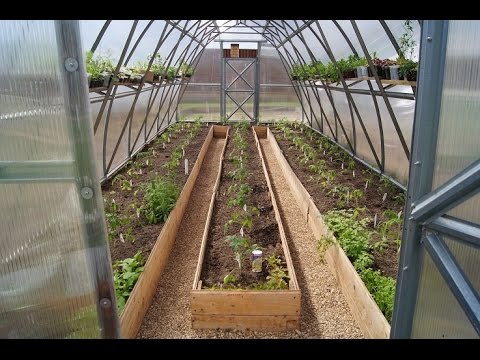

Watch this video on YouTube
Caring for tomatoes in the greenhouse
How to grow tomatoes in a greenhouse
Tomatoes should be left alone for several days after transplanting, and after 5 or 6 days it is necessary to carefully loosen the top layer of the soil in order for the air to better flow to the root system of the tomatoes. While the plants will be planted, it is necessary to install supports for their garter. In this case, both trellises and pegs are suitable for a garter.
As pegs, you can use cuttings of reinforcement, metal rods, wooden slats, plastic pipes of small diameter. It should be borne in mind that the pegs should be 25-30 centimeters higher than the tomato, since it is to this depth that they should be driven into the ground. The stakes should be placed near the stems.It should be tied up as the bush grows.
Trellis should be preferred when growing giant varieties because they save space. So, in this case, 3 or 4 bushes can be planted on 1 square meter. Stakes should be driven along the row, the height of which should be 1.8–2 meters, and a strong twine or steel wire should be pulled horizontally along them every 35–40 centimeters. As the tomatoes grow, their shoots must be tucked between these horizontally located guides, like a wicker. Growing tomatoes in this way, you do not need to cut off the side shoots, in this regard, it will be possible to collect a richer harvest.
The first time the tomatoes need to be pinned before planting it in open soil or immediately after this procedure, while the hemp remaining on the bush should have a height of 2 to 3 centimeters. However, pruning the stepchildren is not recommended, because in this case the tomatoes can be infected with various fungi and viruses, instead they are simply broken off. Stepson should be carried out in the morning, since during this period the stepsons will be the easiest to come off. In the event that you do not want to throw out your stepchildren, you can place them in a container with water with the broken end down. After a few days, such stepchildren will give roots, after which they can be planted in the soil in a greenhouse. The frequency of pinching tomatoes in a greenhouse is 1 time in 7 days. When the tomatoes are poured, all the lower leaves must be torn off, so the stems should be completely bare. Thus, ventilation will be much better, and the humidity, contributing to the appearance of rot, will be lower.
Tomatoes will grow and develop best if the temperature in the greenhouse is between 20 and 25 degrees during the day and 16 to 18 degrees at night. After the tomatoes begin to pour, the temperature should be increased, so it should be 24-26 degrees during the day, and 17-18 degrees at night. In a greenhouse, the humidity level should be approximately 60–65 percent. It is imperative to ventilate the greenhouse systematically, special attention should be paid to this procedure during the flowering of plants, make sure that there is no condensation on the film during this period. If the soil is waterlogged, the tomatoes will become watery and acquire a sour taste, while their fleshiness will be much less.
For ovaries to appear in greenhouse tomatoes, pollination will need to be done manually, since there are no bees here. Choose a cloudless day and shake the brushes gently and immediately moisten the flowers and soil with water from a fine spray bottle. After a couple of hours, you need to open the vents in order for the humidity to become lower.
Watering tomatoes in a greenhouse
After the plants are planted in the greenhouse, they should not be watered for 7-10 days, as otherwise they will begin to stretch and root poorly. It should be borne in mind that the success of cultivating such a vegetable crop in greenhouse conditions depends on proper watering. So, in different periods of growth and development of plants, there is their own watering regime, and this applies to the frequency and abundance of this procedure. So, watering the seedlings should be moderate and relatively frequent, while adult plants are watered somewhat less often, but more abundantly. You can understand that tomatoes should be watered over the top leaves. So, if they begin to curl, then the plants need to be watered as soon as possible. However, in the case when the ripening fruits begin to burst, this indicates that the watering was too abundant.
Before the fruits begin to set, you need to water the tomatoes often (every 5-6 days) and at the same time abundantly. 1 bush should be poured from 4 to 5 liters of water, while the substrate should be moistened to a depth of 15 to 20 centimeters. When the tomatoes are tied, watering is carried out more often (2 or 3 in 7 days), but now 3-4 liters of water are taken for 1 bush.When watering is done, it is imperative to ventilate the greenhouse, since due to the high humidity of the air, the plant can get late blight or other dangerous diseases. In the event that the greenhouse is compact in size, then you can water the tomatoes by hand using a hose or watering can. You should not water the plants with cold water, in this regard, it is recommended to install a 200 liter barrel on the site, so you will always have warm and settled water. During watering, water should be poured exclusively at the root. Avoid getting droplets on leaf plates or tomatoes, as this can cause sunburn.
If the greenhouse is large enough, then it is recommended to install a drip system for irrigation. Installing such a system can be quite inexpensive, while it will make the life of a gardener much easier. Positive aspects of drip irrigation:
- water goes directly to the tomato root system;
- less water is consumed compared to manual irrigation;
- yield increases almost 2 times;
- the soil is not saline or washed out;
- you can water at any time of the day without much effort.
If the greenhouse is very large, then an installed automatic irrigation system is used for irrigation, which is intended for industrial use.
You can water the tomatoes very early in the morning, while the sun is still not very hot, but most often at this time the water is still too cold. And for irrigation, it is recommended to use water at the same temperature as the soil in the greenhouse. If the plants are watered in the evening, the water has time to heat up, but it is impossible to ventilate the greenhouse at this time, because the plants can become supercooled, and after they are watered, the humidity becomes much higher, which can provoke the appearance of rot and other infections. Watering tomatoes during the day is also not the best option, since when droplets hit the foliage and fruits, sunburn appears. Keeping all the possible consequences in mind, you should develop your own most optimal irrigation system.
Top dressing of tomatoes in the greenhouse
Greenhouse tomatoes require 3 or 4 feeding during the season. The first time the plants in the greenhouse are fed 20 days after the seedlings are planted. To do this, use a solution consisting of a bucket of water, 500 ml of liquid mullein and 1 tbsp. l. Nitrofoski, while a liter of nutrient mixture is taken for 1 bush. After 10 days, a second feeding is carried out, for this a solution is prepared from 1 tbsp. l. full fertilizer, a bucket of water and 1 tsp. potassium sulfate, while half a bucket of solution is used for 1 square meter. After 14 days, the beds must be watered with a mixture of 10 liters of water, 1 tbsp. l. superphosphate and 2 tbsp. l. wood ash, with 6 to 8 liters of nutrient mixture being used per 1 square meter.
After the fruits begin to sing, to speed up their filling, the plants can be fed with a solution consisting of 10 liters of water, 1 tbsp. l. liquid sodium humate and 2 tbsp. l. superphosphate, while 1 square meter will need half a bucket of such a mixture.
Tomatoes in autumn in a greenhouse
In order to pick tomatoes in the autumn before the onset of frost, they must be planted in the middle of the summer period. Compliance with several rules will allow you to grow tomatoes before winter:
- For planting in a greenhouse, the correct varieties should be used, so early maturing varieties with small fruits should be preferred.
- For planting in greenhouses, only strong seedlings should be used.
- It is necessary to calculate the time when it is best to plant plants in a greenhouse.
The features of choosing a variety suitable for greenhouses will be described below. If you are going to plant seedlings in the middle of summer, then you need to prepare them and first of all check the plant root system, which must be strong enough.In order to calculate the landing period, you should count from the forecasted date of the frost start from 60 to 85 days. For example, if frosts occur in the last days of October or the first in November, then planting seedlings in a greenhouse is best around mid-August.
Since the planting of tomatoes will be carried out in the heat, then after that for about half a month they will need to be watered systematically and abundantly. And then you can water the plants as usual. Since young tomatoes will be exposed to intense sunlight, it is recommended to install a strip covering or shading net on the west as well as on the south. You can also resort to the budgetary method by sticking in the pegs and pulling old sheets and towels over them, so that the tomatoes are shaded.
There is another way to pick ripe tomatoes until very late autumn. To do this, cut summer tomatoes to stimulate growth. Such bushes require careful watering, as well as feeding with balanced fertilizers.
Tomatoes can also be grown in winter. But since at this time of the year there is relatively little light, the plants will need additional lighting, and this will be reflected in an increase in the cost of fruit. In this regard, in winter, it is recommended to choose cucumbers for growing in greenhouse conditions. Many gardeners have often thought about whether it is possible to grow tomatoes and cucumbers in a greenhouse together? The fact is that tomatoes prefer low air humidity, while cucumbers prefer high. And cucumbers are also afraid of drafts. If necessary, you can try to grow these 2 vegetables in the same greenhouse, but certain rules should be followed.


Watch this video on YouTube
Tomato pests and control in the greenhouse
Caterpillars on tomatoes in a greenhouse
A particular danger for greenhouse tomatoes is represented by caterpillars of gnawing scoops of various colors, which are 3–4 centimeters long. Such pests can settle on various plants, but they love tomatoes most of all. Caterpillars crawl out to feast on the plant at night, while they prefer to gnaw the leaf plates and petioles of tomatoes. In order to catch scoop butterflies, special baits are made; for this, jars filled with fermenting kvass should be hung in the greenhouse (kvass is stirred with water in a ratio of 1: 3 and a small amount of yeast is added). Caterpillars on plants can be collected by hand, and you can also process the bushes with infusion of potato tops or wormwood. Also, in the fight against them, you can use chemical agents, for example, Fitoverm or Agravertin, but experts do not advise doing this.
Whitefly on tomatoes in a greenhouse
It happens that a whitefly settles on greenhouse tomatoes. This butterfly is one and a half centimeter long. Its body is light yellow in color, and the wings are whitish-mealy. The larvae of such a pest are flat, oval, and light green in color. They stick to the leaf plates and suck the juice out of them. In those places where there are such larvae, a bloom of black color is formed from a sooty fungus, and after a while the leaf plates dry up and die off. To combat whiteflies, a solution of the Phosbecid agent is used (10 ml of the drug per bucket of water). Bushes are processed in the early morning or after the sun has set. It will take 2 treatments with an interval of 14–20 days. If flowering has not yet begun, then liquid Soil smoke can be used for processing.
Medvedka on tomatoes in a greenhouse
Medvedka can eat a variety of plants, and you can bring it into the greenhouse along with the soil. Such a pest has a length of 5 centimeters or more. Its nest is located in the ground at a depth of 10 to 15 centimeters, and in it it can lay several hundred eggs.After 20 days, larvae hatch from the eggs, and already they can harm the plants quite a lot. In order to get rid of the bear, you can use hot pepper infusion (for 10 liters of water 150 g), vinegar water is also suitable (for 10 liters of water 2-3 tbsp. Table vinegar). 500 ml of such a solution should be poured into the bear's burrow. You can also use chemical agents, for example: Medvetox, Thunder, Grizzly.
Wireworms on tomatoes in a greenhouse
Wireworms are the larvae of click beetles. Such dense light yellow caterpillars harm the root system of tomatoes, and can also climb into the stem. Traps are used to combat such a pest. 3 or 4 days before the tomatoes are planted in the greenhouse, several not very deep (12-15 centimeters) holes should be made in the ground, and pieces of raw vegetables (potatoes, carrots or beets) should be placed in them, and they should be strung on a stick fifteen centimeters long. Then the trap is buried so that the end of the stick rises above the surface of the ground. After 2-3 days, the traps should be removed from the soil and destroyed. While digging the soil, you can also manually select the larvae and destroy them. The introduction of mineral fertilizers into the soil, as well as its liming, contributes to a decrease in the number of wireworms. You can also use an insecticidal agent Bazudin powder, which is distinguished by its effectiveness. It is mixed with sand or sawdust and dropped into the ground in the immediate vicinity of the bush.


Watch this video on YouTube
Greenhouse tomato diseases and treatments
Why do tomatoes crack?
If the weather is hot for a long time, then cracks may appear on the fruits of greenhouse tomatoes. This phenomenon is not associated with any diseases, but is caused by completely physiological reasons. The fruits begin to burst due to the fact that the abundance of watering sharply increases during a prolonged drought. Quite a lot of water enters the fruits, and the walls of the epidermis that do not withstand are torn. After some time, the resulting cracks dry out, while the fruit begins to sing quickly and stops growing. To prevent cracking of the tomatoes, watering should be done more often, but not using very much water. And in order to keep the soil moist as long as possible, its surface must be covered with a covering material. If the greenhouse is made of glass, then in the heat its surface must be treated with lime milk.
Phytophthora on tomatoes in a greenhouse
A fungal disease such as late blight often bothers tomatoes growing in open soil, however, it can also appear on greenhouse plants.
Tomatoes in the greenhouse do not turn red
In some cases, it may happen that the lower part of the fruit turns red, and the upper one has a green or yellow color. Why does this happen? Most often, this is due to poor lighting, due to the fact that the plants are planted too densely. If the tomato thickets are thick, then it is difficult for light to penetrate to each leaf or fruit, in this regard, some leaf plates must be cut off, and first of all, those located at the very bottom. Also, if necessary, you need to cut off the extra stepsons again. From mid-July, tomatoes stop feeding, because their green mass will actively grow, but the fruits will sing extremely slowly. A longitudinal through-cut should be made in the stem at a height of 15 centimeters from the surface of the ground, its length should be 5–6 centimeters. A sliver must be inserted into this cut to separate the stem parts. This will help reduce the plant's intake of nutrients and water and will also increase the rate at which the fruit ripens.
Tomatoes turn black in the greenhouse
Fruits can turn black for several reasons. For example, a disease such as gray or apical rot may be to blame.Its development is facilitated by improper watering, sudden changes in temperature or lack of calcium. And also the fruits can turn black due to phytophthora. Also, this fault can be high acidity of the soil or a large amount of nitrogen contained in it.
To combat gray rot, you should use a solution of calcium nitrate (1 tbsp per bucket of water). They need to spray the bushes, while those fruits that are affected must be plucked and destroyed. You should also start caring for tomatoes correctly.
Spots on foliage
There are several reasons why spots may form on the foliage of a tomato, namely: too little watering; brown spot or cladosporium; chlorosis, most often it affects seedlings; fungal disease fusarium, it contributes to the disruption of the nutrition of the root system due to injury or hypothermia.
In the event that the watering is too scanty, then the leaf plates at the very top turn yellow and curl. If the soil lacks nitrogen, then in the first half of the period of intensive growth, chlorosis appears, while the plants in the greenhouse turn yellow.
Fusarium is a rather dangerous disease for tomatoes, but it is quite common. In a diseased plant, yellowness forms on the leaf plates, which very often has a light blue tint. After that, the leaves lose their turgor and fade. In affected tomatoes, the roots are intertwined in a ball.
If only the leaf plates that are below become yellow, then this is a sign that the roots were damaged during transplantation or when loosening the soil. However, after the adventitious roots grow, the yellowing of the foliage will stop.
Macrosporiasis is the cause of the appearance of light brown spots with concentric circles on the leaf plates. If the leaves are very badly affected, they die. The specks also appear on the fruit, or rather, on the stalk. You can get rid of this disease in the same way as from late blight.
The greatest danger to greenhouse tomatoes is mosaic... Such a viral disease cannot be cured. You can find out that the plant is infected by the appearance on the leaf plates of an intricate ornament with alternating spots of dark and light colors. Those bushes that are infected become oppressed, they bear very little fruit and eventually die. Diseased bushes should be dug up and destroyed. The appearance of such a virus can be prevented by disinfecting the seeds in a solution of potassium manganese (1%), and seedlings that have grown must be watered 2 or 3 times a day with a solution consisting of a bucket of water and 1 gram of potassium permanganate. Between such treatments, you need to take a break of 20 days.
Rotting fruit
Tomato fruits can rot due to apical or gray rot. A watery speck appears on the bottom of the green infected fruit, and over time it becomes dry, while its color turns brownish-gray. Then a dense crust appears on the surface of the spot, which is capable of cracking. Such rot in a short time affects more than half of the fruit, contributing to the development of mold. In some cases, it is not rotting, but drying of the fruit that occurs. And sometimes, that the plant is sick, you can find out only after the fruits, the inside of which has rotted, fall to the surface of the soil. In the event that a disease is not detected in a timely manner and appropriate measures are not taken, you can be left without a crop at all. This disease develops due to a lack of calcium and an impaired water balance. This is manifested in the fact that at a high air temperature in the cells of the fruit contains an insufficient amount of moisture. If there is such a problem, then a more correct watering regime should be chosen, and the tomatoes should be sprayed with a solution of calcium nitrate (for half a bucket of water from 40 to 50 grams of the substance).And you should also feed such plants, for this, a solution of mineral fertilizer is introduced into the soil, which includes phosphorus and potassium. You can also pour a solution of wood ash under the root, which includes iron, potassium, sulfur, calcium, phosphorus, and zinc (250 grams of ash in a bucket of water).
Also, brown rot (phomosis) can contribute to fruit rotting. It appears only on fruits, so a speck of brown color forms on the stalk. The speck itself is small (3-4 centimeters), but the entire inside of the tomato rots. Such a disease can appear even on green or ripe tomatoes. To combat this disease, it is necessary, before planting the plants, to disinfect the soil, not to feed the tomatoes with fresh manure, not to introduce too much nitrogen into the soil, to pluck and burn infected fruits in a timely manner, to process the bushes with Fundazol or Zaslon.
Also, fruits can begin to rot due to phytophthora.
Collection and storage of tomatoes
Tomatoes have 4 degrees of maturity, namely: green, milky, pink or brown and full. You can pick from plants both fully ripe fruits, and slightly pink, yellow or slightly brown. Unripe fruits can be decomposed in a sunny place and after 1.5-2 weeks they will be fully ripe, while all their taste qualities will be preserved. Green fruits can also be put to ripen in the sun, after picking them, but when ripe, their taste will be somewhat worse than those ripened on the plant. In the event that you pick off only fully ripe fruits, the subsequent ones will become smaller and lose their filling. In this regard, it is recommended to collect brown or pink fruits. Tomatoes are harvested once every 2-3 days, while in the summer or autumn period this procedure is performed every day.
The exact time for harvesting directly depends on the type of plant, on when it was planted, on the weather, and also on the conditions under which the tomato is grown. The first to pick those tomatoes that are fully ripe. They must be torn off together with the stalks and carefully put into boxes. Harvesting should be done until the time when the temperature drops to 8 degrees at night, the fact is that if the temperature is lower, this can contribute to the development of rot. If the fruits are harvested at temperatures less than 4 degrees, then they will definitely deteriorate. Overripe fruits may also begin to rot, in this regard, their collection should be treated responsibly.
Milk ripeness and pink fruits should be placed in a well-lit room, in which the air temperature will be in the range from 20 to 25 degrees, while the air humidity there should be at least 80 percent. Arrange the tomatoes in 1 layer. After 1.5-2 weeks, they should be fully ripe, and you should not forget to systematically ventilate the room. Fresh tomatoes can be stored for 8 to 12 weeks or longer, but they must be prepared to do so. So, fresh ripe fruit must be immersed in water for a couple of minutes, the temperature of which should be 60 degrees, then it is thoroughly wiped with a dry cloth. The fruits warmed up in this way should be put in boxes in 1 layer, each of them must be wrapped in a piece of paper or a napkin, or you can sprinkle them with dry peat or sawdust.
Fruits of early and mid-season varieties, as a rule, cannot be stored for a long time. However, it is quite possible to freeze and store them in the freezer, and in order to thaw them, tomatoes should be dipped in cold water for a while. Frozen tomatoes can be folded into a box and buried in the snow outside.
Tomato varieties and types suitable for the greenhouse
The quality of the fruits themselves, as well as their quantity, depends on the variety and type of tomatoes.
What varieties are
It should be remembered that varieties suitable for growing in greenhouse conditions must have the following qualities, namely:
- Productivity. Distinguish between very high, high and low yield. In greenhouse conditions, hybrid varieties give the highest yield, since they are highly resistant to diseases, as well as to changes in their environment.
- The type and size of the bush. There are determinant varieties that grow to a certain size and do not need pinching, pinching, and garter. There are semi-determinant (half-life) varieties - they are early ripe, have short internodes, and they are also resistant to various diseases, while the bush can reach 200 centimeters in height. Indeterminate varieties - they need pinching, garter and pinching, as they constantly grow both in width and height. Popular indeterminate varieties: Midas, Pink Tsar, Mushroom basket, Honey Spas, Scarlet Mustang, Southern Tan. Popular half-days are Japanese crab, Anyuta, Simona. Popular determinant varieties - Riddle, Seagull, Pink honey, Ballerina, Asteroid, Eleanor, Dama.
- Ripening time. Tomatoes are distinguished by ultra-early ripening, early ripening (Hurricane, Renet, Samara), as well as early ripening (Dina variety, hybrids: Typhoon, Ilyich, Semko 98, Druzhok, Verlioka, Poisk, Semko-Sindbad).
- The quality of the taste. For example, thin skin and juicy flesh or fleshy and very sweet.
- Fruit size. Large-fruited varieties are distinguished: Cap of Monomakh, Eagle Heart, Cardinal, Biysk Rose, King of London, Black Sea, Dream, Mikado, Orange Miracle, Queen of the Market, Canadian giant, Abkhazian, Russian soul. There are also small-fruited varieties: Sanka, Kaspar, Robot, Countryman, Ventura, Legend, Piket, Italy, Herringbone, Yellow drop, Kubyshka, Sugar plum, Cherry, Shuttle. Medium-fruited varieties: Bulb, Brilliant, Peter I, Slavic masterpiece. And also varieties like "cherry" - Minibel, Cherry red, Bonsai, Cherry yellow. Hybrids - Cherry Tomato, Zelenushka, Golden Bead.
- How resistant the plant is to diseases, harmful insects, frost and adverse conditions. The best varieties here are: Intuition, Budenovka, Erema, Evpator, Blagovest, Roma, Chio-chio-san, Kostroma.
- Keeping quality. A very important quality for those who are going to store the crop. The best varieties here are: Akatui, Krasnobay, Salahaddin, Ivanovets, Volgogradets.
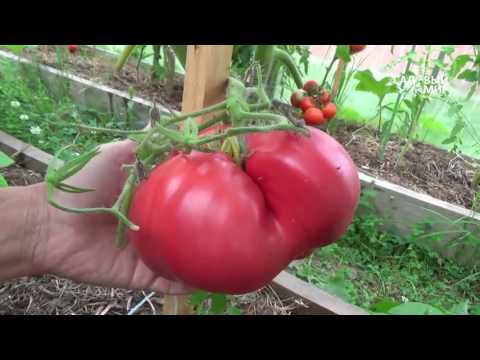

Watch this video on YouTube
The best varieties of tomatoes for greenhouses
These varieties are the most popular with gardeners:
- Gondola - mid-season hybrid gives a high yield, is indeterminate. Created in Italy. The dense fruits are deep red and have a very good keeping quality. On average, tomatoes weigh 160 g, but often they reach more than 500 g. These fruits are used fresh, pickled, salted, and also prepare sauces.
- Hurricane - this hybrid is early maturing and gives a good harvest. After 85 days after germination, you can start harvesting. Fruits weigh 80-90 grams, and they are eaten both fresh and canned.
- Major - an indeterminate variety, is fruitful. There is resistance to diseases and adverse weather conditions. Tomatoes are sweet, fragrant, and their pink flesh is quite dense.
- Silhouette - this hybrid is medium-early yielding, there is resistance to adverse conditions. Rounded tomatoes are slightly flattened, have high taste.
- Pink king - a determinant variety that is mid-season and fruitful. Flat-round tomatoes have a deep pink color.
- Long Keeper - late-ripening fruitful variety. The bush is medium-sized, round, the fruits are large, their average weight is 300 grams, ripening occurs in maturation.
- Lelya - the hybrid has appeared recently, it is early maturing and fruitful. The mass of red fruits is about 100 grams, the taste is sweet and sour.
- Kochava - hybrid indeterminate, ultra-early maturing and very productive. There is resistance to viruses and fungal diseases. Flat-round tomatoes weigh up to 180 grams.Ripening of a tomato occurs 90 days after the emergence of seedlings.
- Bersola - hybrid determinant ultra-early ripening, productive, undersized bush. Resistant to diseases, adverse conditions. Tomatoes are distinguished by their elasticity, density, and are suitable for transportation.
- Miracle of the earth - is the most popular. The variety is early ripe, high-yielding, tall bush. It is drought-resistant and resistant to sudden temperature changes. Heart-shaped sweet tomatoes can reach 0.9 kg.
- Titanic - a productive hybrid, there is resistance to diseases. Tomatoes are sweet, reddish-pink, and have a high taste.
- Dina - high-yielding variety, medium early, medium-sized bush (1.2 m). Drought-resistant, there is resistance to disease. Round, sweet, rich orange tomatoes weigh from 120 to 150 g, they contain a lot of keratin.
- Moneymaker - the variety is fruitful, versatile, early maturing. There is resistance to disease. Juicy smooth tomatoes, colored pale red, weigh about 100 g.
- Honey drop - mid-early variety is undemanding to care for. Egg-shaped tomatoes are honey-colored, weigh up to 30 g.
- Bull heart - the variety gives a high yield. Juicy fleshy tomatoes weigh no more than 300 g. There are several varieties in which the fruits have different colors: almost black, yellow and red.
- Samara - shoots grow continuously. Rounded sweet tomatoes weigh about 90 g.
Self-pollinated tomato varieties for greenhouses
Tomatoes are self-pollinating, meaning they do not need insects to pollinate. However, in order to harvest a rich harvest, the plants need help. In order to improve pollination, you can:
- Pollinate by hand. To do this, you need a toothbrush or a brush, it should touch all the flowers one by one.
- Fan. The air flow must be directed to the tomatoes, and the wind itself will transfer the pollen from one flower to another.
- Shaking the bushes.
- Attract bees and other pollinating insects. Plant honey plants next to the tomatoes.
- Systematic ventilation of the greenhouse. The wind can carry the pollen.
Pollen on flowers ripens at night, therefore it is better to pollinate flowers in the morning. If the flower is pollinated, then its petals are bent outward.

